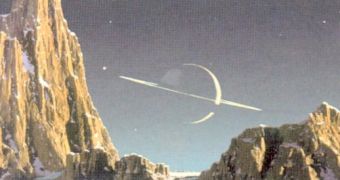Those of you who got bored of climbing all the mountains on Earth might consider an exotic experience on Saturn's largest moon, Titan. I heard they've got some mighty good-looking mountains there. Well, the Cassini-Huygens probe has once again exceeded the expectations and done what no other space probe studying the Saturn planetary system had done before. With the help of the Radar instruments on board, the probe was able to pierce through the thick hazy clouds of Titan's atmosphere and recreate a detailed map of the features on its surface.
Furthermore, the discovery turned into shock as the formation and erosion processes taking place on the surface of Titan are strikingly similar to those usually taking place on Earth. Jani Radebaugh, the lead researcher in the study, is a Brigham Young University professor who, prior to the recent discovery of the mountain features on Titan, also confirmed, in 2006, the presence of sand dunes and lakes of liquid methane.
Previously thought to have formed through similar geological processes as those taking place on our planet, the two-kilometer high icy features are considered relatively short in height, therefore they must have suffered an erosion process which prevents them from growing any bigger. However, Radebaugh cannot point for certain the true nature of these structures and proposes multiple scenarios.
One of the scenarios suggests that they could have been created in the same way as most of the mountains on Earth, meaning crust compression acts on one area of the solid crust, determining horizontal forces to push material together and upwards at the same time. A second possibility would be that the mountain-like structures formed during massive impacts threw large blocks of matter creating high standing structures that were eventually eroded and shrunk.
Not only the surface features of Saturn's moon seem to be similar to some existing on Earth; prior to this discovery, studies regarding the chemical makeup on Titan revealed evidence of presence of organic material, such as water and other organic substances, which are essential for the appearance of life, thus scientists could interpret the processes taking place on the large moon, in order to better understand those which took place before life appeared on Earth.
We mostly know what the essential ingredients necessary for life to appear are, however the key is in finding through what process this event occurred.
In order to better understand the geological processes that take place on other planets and natural satellites, Radebaugh studies our planet in great detail, after which he analyses images coming from out of space. In addition to the discoveries he made until now, Radebugh was also part of the Antarctic Search for Meteorites program and also collaborated with students in order to develop a device meant to determine the temperatures of the magma eruptions on one of the most active volcano bodies in the solar system, Jupiter's moon, Io.

 14 DAY TRIAL //
14 DAY TRIAL //